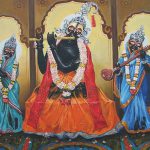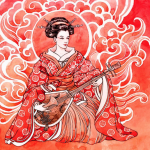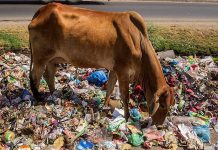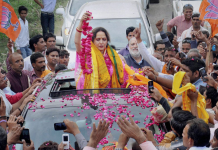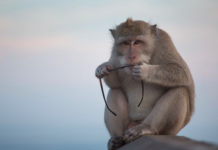by Braja Sevaki Devi Dasi
Vrindavana’s cows feel the pinch as their pasturing grounds disappear.
It was the day before Janmashtami. Crowds of pilgrims were pouring into Vrindavana. The streets were hectic with traffic from Delhi and the surrounding areas. I was being pushed constantly in the press of human and animal traffic, feeling somewhat battered, longing for a solitary place. Suddenly a large bull knocked into me, pushing me into the oncoming traffic. I was hit by a car, breaking both my legs and various other bones on the left side of my body. I lay there in shock, trying to recover my senses. As the reality of what happened sunk in, so did the pain—I couldn’t move, and was bleeding profusely. But the worst was yet to come. The driver of the car got out and asked some bystanders to help him drag me to the side of the road. Imagine the pain! Then he took a can of motor oil from his trunk and poured it on my wounds. What madness was this? He told horrified bystanders that this would keep infection away from my wounds and that I would be okay in a few days. Then he drove off to have the sacred audience of the predominating deities in Vrindavana. I wonder if Lord Krishna gave that driver any blessings? Somehow I doubt it …
Unfortunately, this really happened. Not to me but, worse, to a three-month-old calf named Kamala (“lotus” in Sanskrit). If she could talk, that’s what her story would have sounded like. Instead her tale was told to me by those who had witnessed it. The worst part is, Kamala’s story isn’t unique, rare, or even surprising anymore: it’s a common occurrence.
There are three to four hundred abandoned cows in Vrindavana, roaming the streets looking for food and shelter. I had always been under the impression—one I learned is shared by so many visitors to Vrindavana—that the cows were owned, and that they wandered during the day and returned to their owners at night. While this is true in some cases, most of the cows have been dumped by careless owners. Starving, diseased, and unprotected, they are at danger from the increasing traffic in Vrindavana, and even more from the cattle rustlers who abduct them and sell them to slaughterhouses.
It’s hard to believe that this goes on in Krishna’s village of Vrindavana. Even harder to believe is that several of the goshalas (cow sanctuaries) in town have reported break-ins from these same cattle rustlers trying to steal their protected cows. It seems that Kali-yuga has reached Vrindavana, and the cows especially are feeling it…
But there’s change ahoof.
Won Over by a Chocolate-Colored Calf
On a cold December morning, while a thin fog clung to the air with spidery fingers, I pulled my wrap closer around me and burrowed into its warmth as I walked the dusty track out of town. I was in Vrindavana for a week-long retreat. I had been looking forward to the opportunity, and had no intention of going anywhere: no day trips, no social outings, nothing. I was here to spend time with friends I hadn’t seen for many years, and maybe sit at a holy site and chant Hare Krishna. It was going to be a well-earned break, a peaceful, solitary week on my own—or so I thought. I had no idea what was about to happen: My life would change, and the catalyst would be one nameless, tiny, broken, chocolate-colored calf.
My old friend Syama Gauri Dasi welcomed me at the tall iron gates. I stepped in and took in the scene: a peaceful, clean yard, divided down the middle by a brick wall covered with a mix of cow dung and mud; haysheds, cowsheds, and fenced yards at the back, all washed with the same mixture, which gave a finish that was both pleasing to the eye and purifying to the atmosphere. It was the home of Care For Cows, and Syama Gauri had invited me to this place where she spent a few days each week tending to Vrindavana’s abandoned and injured cows, calves, and bulls.
It felt good in that yard: The smell was country-fresh, a smell of cows, hay, cow dung, and all things good and clean. Over the brick wall, an empty yard that later in the day would house around ninety full-grown cows and bulls was at present the roaming ground of a solitary huge gray bull named Baba. In the distance, through the hayshed, I could see a fenced area at whose gate stood about twenty young cows and bulls, all under a year old, all too little to mingle with the grown ups. I would later refer to this area as “the playpen,” but for now it was just the cow yard, and its inhabitants were curious about my arrival.
It was then I saw that little chocolate-brown calf I mentioned. Lying against the brick wall, propped up by pillows and bags of hay, she lay soaking in the warm morning sun. Her eyes were closed, and they barely moved as we approached.
“This little one came in two days ago,” Syama Gauri told me. “She was found by devotees who were on their way to the Dauji temple in Gokul. Her leg is broken and her hip is dislocated. She has these open wounds on her side, and we don’t know how seriously hurt she is internally. She was lying there for a week. No one did anything to help her. The devotees picked her up, put her in their car, and returned to town. They brought her straight here. We’re not sure if she’ll make it.”
Proud to Be a Cow-lover
Well, it’s right about here that the story becomes a heart-wrencher. It’s hard to hear things like this about God’s tiny creatures. It’s harder to see it in person. You might wonder if I’m just some bleeding-heart cow-lover who’s trying to “campaign” for some mistreated cows. Well, sure I’m a cow-lover—any devotee would have to be, almost by default. The Vedic scriptures are full of references to these most exalted animals who are the favorite of the Supreme Personality of Godhead, Lord Krishna.
Krishna is the very life and soul of the damsels of Braja. His entire body is covered with the fine dust raised by the hooves of calves, and He carries a flute tucked into the dhoti tied around His waist. His mellifluous voice captivates all the cows. (Stava Mala, Srila Rupa Goswami)
These simple lines are valid, essential knowledge. But I can’t say I’ve full realized it. Most of us are a long way from appreciating Krishna with the same sentiments that the gopis do, or with the understanding that great personalities such as Srila Rupa Goswami possess about the intimate pastimes of Krishna in His abode of Goloka Vrindavana. Yet this brief journey into the world of abandoned and abused cows in Vrindavana was starting to have an effect on me. It is bound to give one a lot to think about in terms of one’s eternal relationship with Krishna, and His relationship with His dearly beloved cows.
Krishna is worshiped as namo brahmanya-devaya. His first business is to give protection to the cows and the brahmanas.” (Srila Prabhupada letter, June 16, 1974)
Most of us might very likely go through life without having to give a second thought to the cows of Vrindavana. In some ways that wouldn’t be so bad, because it’s hard to see their state, painful to watch them brought in to the Care For Cows clinic with horrific injuries. It’s heartbreaking to watch them cringe when a hand is raised because they’ve been so poorly treated, or run away in fear when they hear a loud voice. But in truth it’s a good thing to be given an opportunity to give time, service, and love to a tiny Vrindavana cow who can’t stand, can’t move, and has no energy to even raise her head to feed. There’s a chance of coming closer to Krishna in caring for these cows, understanding their specialness, and knowing for a brief moment why it is that Krishna prefers their company every single day. Or why the planet where He resides is called Goloka Vrindavana, which means “planet of the cows.” It’s no accident—He is the Lord of all creation, yet he chooses to spend His days with cows. That’s definitely some kind of wonderful.
Just like Brahma is offering a prayer, surabhir abhipalayantam. “Krishna, Govinda, You are so fond of Your surabhi cows that You are always engaged in taking them to the forest and enjoy with Your cowherd boys.” The Mayavadi will think, “What is this? God has become a cowherd boy? How is that? He must be very exalted. How is it that He is a cowherd boy?” But he does not know the nature of the Lord. He’s free. He loves everyone. He loves His great devotee, He loves the cows, He loves the calves, He loves the trees, fruits, flowers, water, everything, because everything is a manifestation of His energy. (Srila Prabhupada, Lecture on Srimad-Bhagavatam 1.8.44, Los Angeles, May 6, 1973)
And there I was, standing in a cow yard, knowing that despite the fact that the most holy of holy sites, Sri Radha-kund, was a few miles away, or that a proliferation of temples of Krishna surrounded me, or that the most worshipable Govardhan Hill was close by, still I was standing in the right place, the best place, the only place I wanted to be: right amongst Krishna’s cows.
Vrindavana is within the sacred area known as Braja, which means “pasturing grounds” in Sanskrit. Scriptures such as Srimad-Bhagavatam and Chaitanya-charitamrita repeatedly mention how significant it is that the most holy place of Krishna’s pastimes is within pasturing grounds. Unfortunately, due to the development of the town of Vrindavana and the hold that greedy land-owners have on it, there are no pasturing grounds left for the cows, and they are forced to forage amongst rubbish piles and along the streets for food. Just like little Kamala, who was pushed into traffic by a large, hungry bull.
Caring for Kamala
Kamala’s story has a happy ending though. Her “testimonial” continues:
A kind lady reported the accident to Care For Cows, and within fifteen minutes I was loaded onto their ricksha and taken to their clinic. My wounds were cleaned of the motor oil, and my legs were set in casts. I was then given a private room and a diet of fresh grass, hay, and barley flour. After a few days I could stand for about fifteen minutes at a time. A cowherd looked after me, giving me fresh water, massages, and encouragement. After a month my casts were removed, and thanks to Care For Cows, I can walk normally again.
Care For Cows exists because of the efforts of Kurma Rupa Dasa, a disciple of Srila Prabhupada and a long-time resident of Vrindavana. Because of his selfless service, cows like Kamala and my chocolate-colored friend—who is now named Pushpa (“flower”)—have found a home. Care For Cows doesn’t just heal patients like Kamala and Pushpa—it gives them a home for life. They’re not returned to the streets once they’re well to suffer the same fate. When they grow, they spend their days on a few acres of borrowed land not far from the Care For Cows yard. In the afternoons, they return to the yard that Baba occupies alone in the mornings—he was also a victim of a broken leg in his youth, and is retired to the yard. There they are fed well, brushed, and housed at night, warm together in the cold winter nights, secure in the knowledge that they don’t have to risk traffic, disease, and cattle rustlers to get their next feed.
Yes, I’m a cow-lover. But it’s okay to be a cow-lover: it’s a substantial thing. Srila Prabhupada said during a lecture: “So our Krishna consciousness movement is not a sentimental movement. It takes care of all-round social organization. It is not something like religious sentiment. Everything should be taken care of. Therefore we say cow protection, cow protection.”
Cow protection is not a temporary campaign; to ignore the plight of cows is a very real threat against our human existence and the hope of attaining spirituality. In 1915, Nobel Prize winner Romain Rolland wrote:
To a man whose mind is free there is something even more intolerable in the sufferings of animals than in the sufferings of man. For with the latter it is at least admitted that suffering is evil and that the man who causes it is a criminal. But thousands of animals are uselessly butchered every day without a shadow of remorse. If any man were to refer to it, he would be thought ridiculous. And that is the unpardonable crime.
It’s an “unpardonable crime” that Krishna’s cows are suffering. But it is a mere reflection of the state of the earth and the consciousness of its inhabitants.
While the world suffers the effects of cow slaughter internationally, we can at least maintain our own “backyard,” that place from which our spiritual lives emanate, Sri Vrindavana-dhama, and its most glorified inhabitants: Krishna’s cows.
Anyone who meditates on Lord Krishna’s birth, His protecting the cows, His singing charming songs with the gopas, and His other pastimes, will find himself overcome with bliss and love. (Gopala-campu 1.97, Srila Jiva Goswami).





